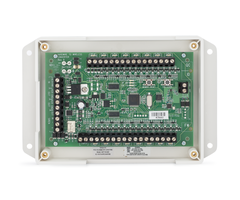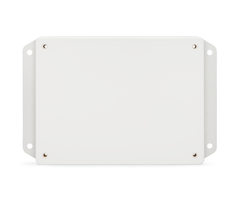How Do I Add a High Current Siren Using the Qolsys IQ Hardwire 16-F?
You can add a high current siren using the Qolsys IQ Hardwire 16-F by adding an external relay and a power supply. This setup is required when the siren draws more than 500mA of power. The IQ Hardwire 16-F tells the relay to activate so that external power is provided to the siren.
 The primary function of the Qolsys IQ Hardwire 16-F is to serve as a wired to wireless converter for the legacy Interlogix/GE Version of the Qolsys IQ Panel 2 Plus, as well as almost any other system that supports the 319.5 MHz wireless frequency. Hardwired sensors connect with the IQ Hardwire 16-F so that they can be used with a compatible wireless alarm panel.
The primary function of the Qolsys IQ Hardwire 16-F is to serve as a wired to wireless converter for the legacy Interlogix/GE Version of the Qolsys IQ Panel 2 Plus, as well as almost any other system that supports the 319.5 MHz wireless frequency. Hardwired sensors connect with the IQ Hardwire 16-F so that they can be used with a compatible wireless alarm panel.
Important Note: This FAQ is geared toward the IQ Panel 2 and IQ Panel 2 Plus. If you are looking for information specific to the IQ4 Series panels, you can find that information here. Much of the information is the same, specifically the wiring and current draw information, but there are differences in panel behavior. Specifically, the IQ Panel 4 will NOT activate the siren output of the Hardwire 16-F when a siren test is run. The above video was made before the IQ4 Series panels existed so that information is not included in the video. As of Firmware 2.7.2, the IQ2 no longer activates the siren output of the Hardwire 16-F when a panel siren test is run. We are unsure in which firmware update this behavior changed.
But another function of the IQ Hardwire 16-F is to operate as a wireless relay between the 319.5 MHz IQ Panel 2 Plus and a wired siren. On its own, the IQ Hardwire 16-F unit can support a siren that draws up to 500mA of current. You can even connect multiple sirens daisy chained together, as long as the total load does not exceed 500mA. But once the load exceeds this limit, you will need to get extra equipment involved. This includes an external relay and a power supply. If you are wanting to use multiple sirens with the 16-F, then we recommend reviewing this helpful FAQ.
When you are setting up a relay with the IQ Hardwire 16-F, you can basically follow the same process for connecting a regular siren. The relay connects with the 16-F, the added power supply, and the siren. The power supply will need its own plug-in transformer and backup battery. There will be a diagram later in this FAQ to provide a detailed look at all of the relevant connections.
Remember, the IQ Panel 2 Plus System is treating the IQ Hardwire 16-F as a wireless siren relay in this setup. This is only possible for the 319.5 MHz IQ Panel 2 Plus. No other alarm system can support the 16-F as a wireless siren relay, even if it supports the 319.5 MHz frequency. Additionally, the Qolsys IQ Panel 2 Plus System must have an RF PIC Version of 11.1.4 G2 or higher. The RF PIC version cannot be upgraded, so if your system doesn't meet this requirement you will need to get a new 319.5 MHz IQ Panel 2 Plus if you want to set up a Qolsys IQ Hardwire 16-F as a wireless siren relay. You can check the RF PIC Version by clicking the small grey bar at the top of the main IQ2 screen, and choosing Settings > Advanced Settings > Installer Code (default 1111) > About Hardware > RF PIC Version. The panel shown below would need to be replaced in order to support this configuration.

You will want to ensure that the high current siren you are using does not overload the power supply. If you are using multiple sirens, then determine the total load, and make sure that it does not exceed the current that is available. For the purpose of this FAQ, we will be using a Honeywell AD12612 Power Supply rated at 1.2 A, an Altronix RB5 Relay, a Honeywell 1361-GT Transformer, an UltraTech 1240 Battery, and stranded copper 18-2 alarm wire. Another limitation to consider is the contact rating of the relay being used. The contact rating is the amount of current and voltage that can be routed through the relay without damaging it. The RB5 has a contact rating of 5A/220VAC or 28 VDC. This indicates that you can route 5 Amps at 220 Volts AC, or 28 Volts DC through the RB5. This is a robust relay and should be able to handle nearly any siren configuration.
Remember that you must also program the Qolsys IQ Hardwire 16-F module with the panel itself. Each of the (16) zones must have an end-of-line resistor (EOLR), even if a zone is not actively being used. The EOLRs and all zone wiring should be added prior to powering on and programming the module. To learn how to configure a 16-F with an IQ2 System, please refer to this FAQ. Please also review this other FAQ for more information on using resistors with the 16-F converter. The steps in this FAQ assume that this has already been completed.
As a summary, the following connections are made when adding a high current siren to the 16-F using a power supply and relay:
- Jumper between AUX Out and Siren IN on the Hardwire 16-F.
- Negative (GND) Terminal on the Hardwire 16-F to Negative (-) Terminal on the Altronix RB5 Relay.
- Positive (OUT) Terminal on the Hardwire 16-F to Positive (+) Terminal on the Altronix RB5 Relay.
- Common (C) on the Altronix RB5 Relay to DC NEG (-) on the Honeywell AD12612 Power Supply.
- Normally Open (NO) on the Altronix RB5 Relay to NEG (-) on the high current siren(s).
- DC POS (+) on the Honeywell AD12612 Power Supply to POS (+) on the high current siren.
- Connect POS (+) from any additional siren in the sequence to POS (+) on the previous siren in the sequence (optional).
- Connect NEG (-) from any additional siren in the sequence to NEG (-) on the previous siren in the sequence (optional).
- Connect two (2) AC wires from the Honeywell 1361-GT Transformer to the AC Transformer Terminals on the Honeywell AD12612 Power Supply. Polarity does not matter here.
- Connect the UltraTech 1240 Backup Battery to the Honeywell AD12612 Power Supply where indicated.
- Set SW1 OFF on the Altronix RB5 Relay for 12V operation.
- Have the jumper in-place on the Honeywell AD12612 Power Supply for 12V operation.

Complete the following steps to add a high current siren to a Qolsys IQ Hardwire 16-F using an external relay and power supply:
1. Connect the relay. You connect the Altronix RB5 Relay to the IQ Hardwire 16-F just like a regular siren. Place a jumper between the AUX OUT Terminal and the Siren IN terminal on the 16-F. In between the jumper, run a wire from GND (-) on the 16-F to Negative (-) on the RB5 Relay. Then run another wire from OUT (+) on the 16-F to Positive (+) on the RB5 Relay. Set SW1 on the RB5 Relay to OFF for 12V operation.
2. Add the power supply. Connect Common (C) on the RB5 to Negative (DC-) on the Honeywell AD12612 Power Supply. Then connect Normally Open (NO) on the RB5 Relay to Negative (-) on the high current siren. Next, connect Positive (DC+) on the Honeywell AD12612 Power Supply to Positive (+) on the high current siren. Then connect the two (2) AC terminals on the Honeywell 1361-GT Transformer to the AC transformer terminals on the Honeywell AD12612 Power Supply. Again, polarity does not matter, so you do not have to worry about mixing up these wires. Also connect the UltraTech 1240 Backup Battery to the battery leads on the power supply. Observe polarity when connecting the battery. Have the jumper placed on the Honeywell AD12612 Power Supply for 12V operation.
Note: The IQ2+ System and the added power supply cannot share a transformer.
3. Test the setup. Remember to put your system on test mode with the central station before testing the siren setup. For panels on older firmware, you can click the small grey bar at the top of the IQ2+ screen. Select Settings > Advanced Settings > Installer Code (default 1111) > System Tests > Panel Tests, and then scroll down to Sirens, and choose Run. At some point, a firmware update took away this option for testing the Hardwire 16-F in the IQ Panel 2 (as of 2.7.2, but possibly earlier). Initiating a panel siren test won't test the Hardwire 16-F. For those panels, and for the IQ4 Series panels, you will need to cause an audible alarm in order to test the siren output. Arm the system and set off a burglary alarm to test, again making sure that your system is on test with the monitoring station if you have full monitoring.
Did you find this answer useful?
We offer alarm monitoring as low as $10 / month
Click Here to Learn MoreRelated Products


Related Videos
Related Categories
- Alarm Sirens
- Sirens
- Alarm Sirens & Strobes
- Wired Alarm Sirens
- Sirens
- Alarm Sirens & Strobes
- Alarm Sirens
- Answered

